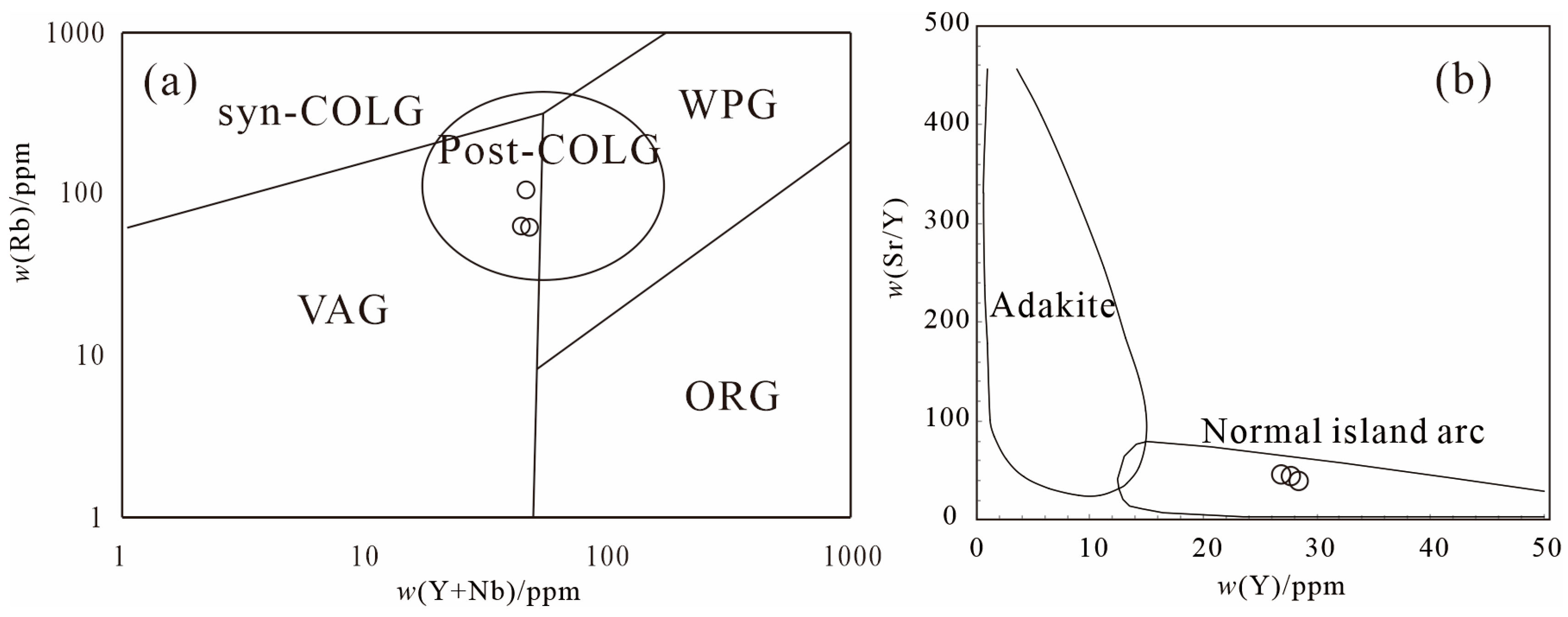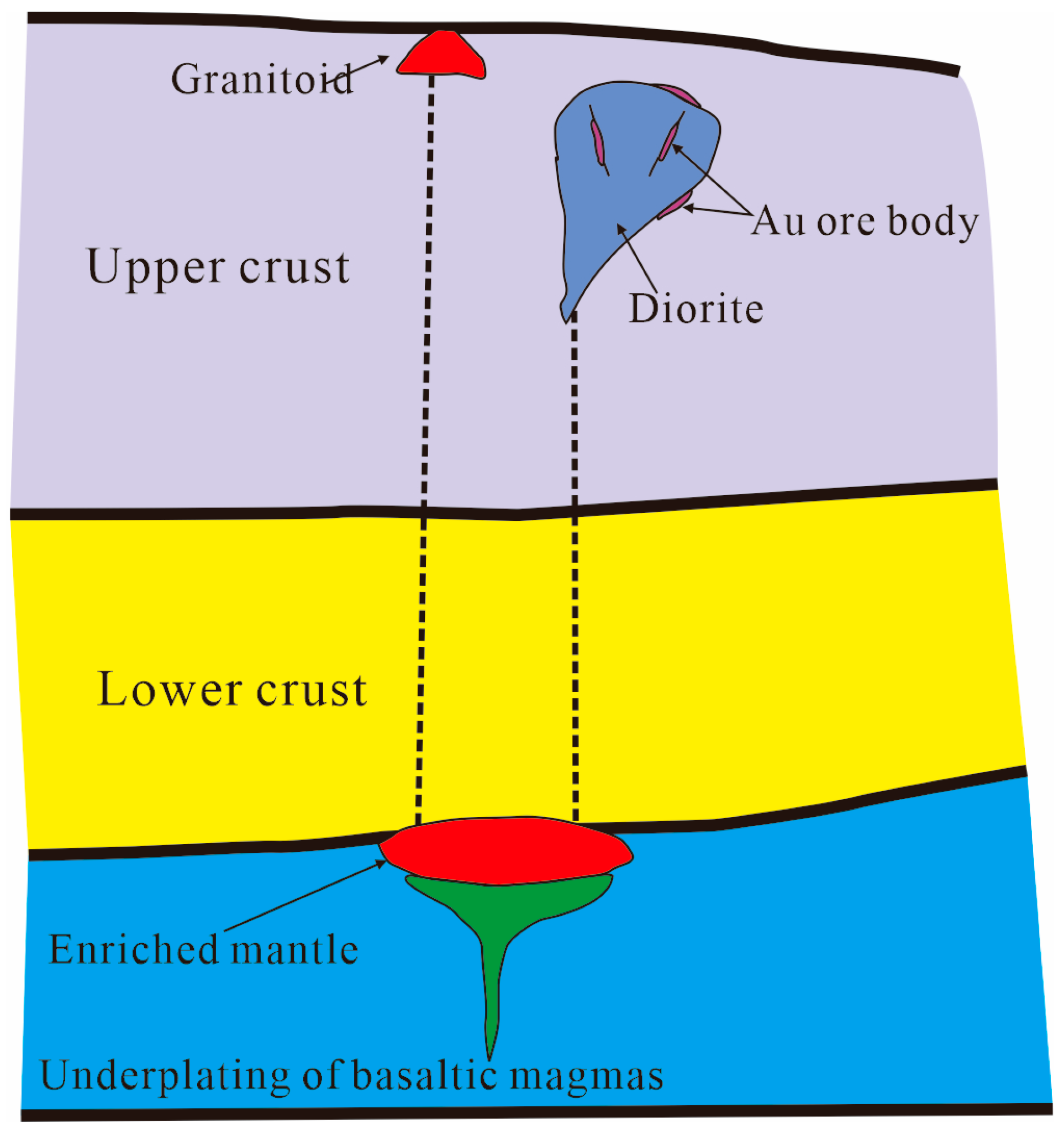Age and Source of the Jinjingzui Skarn-Type Gold Deposit in the Southeastern Hubei Province, China
Abstract
1. Introduction
2. Regional Geology and Ore Deposit Geology
2.1. Regional Geology
2.2. Local and Mine Geology
3. Sampling and Analytical Methods
4. Analytical Results
4.1. Major Elements and Trace Elements
4.2. Molybdenite Re–Os Dating
4.3. Sulfur and Lead Isotopic
5. Discussion
5.1. Petrogenesis
5.2. Timing of Mineralization
5.3. Origin of Ore-Forming Materials
5.4. Implications of Regional Mineralization
6. Conclusions
- (1)
- Molybdenite Re–Os dating indicates that the deposit formed in 138 Ma in the age of Ore-bearing diorite, indicating that both the diorite and the Au mineralization at Jinjingzui formed during the Early Cretaceous period.
- (2)
- Geochemical and relatively uniform εNd(t) and zircon Hf isotopic compositions confirm that characteristics collectively indicate that the petrogenesis and mineralization of Jinjingzui occurred in a tectonic setting characterized by lithospheric extension and thinning.
- (3)
- S-Pb isotope components and high Re concentrations in the molybdenites suggest the metallic components originated from the upper mantle and the lower crust but with a higher mantle component involved in the mineralization than other deposits in the district.
Author Contributions
Funding
Institutional Review Board Statement
Informed Consent Statement
Data Availability Statement
Acknowledgments
Conflicts of Interest
References
- Xie, G.Q.; Mao, J.W.; Zhao, H.J. Zircon U–Pb geochronological and Hf isotopic constraints on petrogenesis of Late Mesozoic intrusions in the southeast Hubei Province, Middle–Lower Yangtze River belt (MLYRB), East China. Lithos 2011, 125, 693–710. [Google Scholar] [CrossRef]
- Mao, J.W.; Xie, G.Q.; Chao, D.; Pirajno, F.; Ishiyama, D.; Chen, Y.C. A tectono–genetic model for porphyry–skarn Cu–Au–Mo–Fe and magnetite–apatite deposits along Middle–Lower Yangtze River Valley, Eastern China. Ore Geol. Rev. 2011, 43, 294–314. [Google Scholar] [CrossRef]
- Pan, Y.; Dong, P. The Lower Changjiang (Yangzi/Yangtze River) metallogenic belt, East China: Intrusion-and wall rock-hosted Cu–Fe–Au, Mo, Zn, Pb, Ag deposits. Ore Geol. Rev. 1999, 15, 177–242. [Google Scholar] [CrossRef]
- Chang, Y.F.; Liu, X.P.; Wu, Y.C. The Copper Iron Belt of the Lower and Middle Reaches of the Changjiang River; Geological Publishing House: Beijing, China, 1991; pp. 1–379. (In Chinese) [Google Scholar]
- Zhai, Y.S.; Yao, S.Z.; Lin, X.D.; Zhou, X.N.; Wan, T.F.; Jin, F.Q.; Zhou, Z.G. Fe–Cu–Au Metallogeny of the Middle–Lower Changjiang Region; Geological Publishing House: Beijing, China, 1992; pp. 1–235. (In Chinese) [Google Scholar]
- Samake, B.; Xu, Y.M.; Jiang, S.Y. Oxygen fugacity, temperature and pressure estimation from mineral chemistry of the granodiorite Porphyry from the Jilongshan Au-Cu deposit and the Baiguoshu Prospecting area in SE Hubei Province: A guide for mineral resource Exploration. J. Geochem. Explor. 2018, 184, 136–149. [Google Scholar] [CrossRef]
- Li, J.W.; Zhao, X.F.; Zhou, M.F.; Vasconcelos, P.; Ma, C.Q.; Deng, X.D.; Zhao, Y.X.; Wu, G. Origin of the Tongshankou porphyry–skarn Cu–Mo deposit, eastern Yangtze craton, Eastern China: Geochronological, geochemical, and Sr–Nd–Hf isotopic constraints. Minera Lium Depos. 2008, 43, 319–336. [Google Scholar] [CrossRef]
- Li, J.W.; Deng, X.D.; Zhou, M.F.; Liu, Y.S.; Zhao, X.F.; Guo, J.L. Laser ablation ICP-MS titanite U–Th–Pb dating of hydrothermal ore deposits: A case study of the Tonglushan Cu–Fe–Au skarn deposit, SE Hubei Province, China. Chem. Geol. 2010, 270, 56–67. [Google Scholar] [CrossRef]
- Xie, G.Q.; Mao, J.W.; Zhou, S.D.; Ye, H.S.; Yan, Q.R.; Zhang, Z.S. SHRIMP zircon U–Pb Dating for dating rocks of the Dasi Formation in southeast Hubei Province, Middle of the Lower reaches of the Yangtze River and its implications. Chin. Sci. Bull. 2006, 51, 3000–3009, (In Chinese with English Abstract). [Google Scholar] [CrossRef]
- Xie, G.Q.; Zhao, H.J.; Zhao, C.S.; Li, X.Q.; Hou, K.J.; Pan, H.J. Re–Os dating of molybdenite from Tonglushan ore district in southeastern Hubei Province, Middle–Lower Yangtze River belt and its geological significance. Miner. Depos. 2009, 28, 227–238, (In Chinese with English Abstract). [Google Scholar]
- Xie, G.Q.; Mao, J.W.; Zhao, H.J.; Wei, K.T.; Jin, S.G.; Pan, H.J.; Ke, Y.F. Timing of skarn deposit formation of the Tonglushan ore district, southeastern Hubei Province, Middle Lower Yangtze River Valley Metallogenic Belt and its implications. Ore Geol. Rev. 2011, 43, 62–77. [Google Scholar] [CrossRef]
- Zhou, T.F.; Wang, S.W.; Yuan, F.; Fan, Y.; Zhang, D.Y.; Chang, Y.F.; White, N.C. Magmatism and related mineralization of the Intracontinental porphyry deposits in the Middle Lower Yangtze River Valley metallogenic belt. Acta Petrol. Sin. 2016, 32, 271–288, (In Chinese with English Abstract). [Google Scholar]
- Jiang, S.Y.; Duan, D.F.; Xu, Y.M.; Samake, B.; Li, Z.H. Geological characteristic and discrimination criteria of the ore related granitoids from the Edong and Juirui districts in the Middle Belt. Acta Petrol. Sin. 2019, 35, 3609–3628, (In Chinese with English Abstract). [Google Scholar]
- Li, Y.; Cheng, C.; Su, S.M.; Gao, J.F.; Huang, F.X.; Xiong, Y.Z.; Zhang, Y.; Huang, H. Sr- Nd and zircon Hf isotopic constraints on petrogenesis of the Early Cretaceous diorite in the Jinjingzui gold deposit, southeast Hubei Province. Geol. China 2023, 50, 1573–1585, (In Chinese with English Abstract). [Google Scholar]
- Li, X.H.; Xie, G.Q.; Li, W.; Zheng, X.W.; Liu, M. Geological characteristics, U–Pb age and Hf isotope of zircon in hosting intrusion for Baotuanshan au-cu deposit, Edong ore cluster and its geological significance. Geol. Bull. China 2018, 37, 1346–1359, (In Chinese with English Abstract). [Google Scholar]
- Su, X.D. Geological characteristics of the first altered diorite tubular gold deposit in China. Geol. Explor. 1996, 3, 1–6. (In Chinese) [Google Scholar]
- Pang, A.J.; Li, S.R.; Santosh, M.; Yang, Y.Q.; Jia, B.J. Geochemistry, and zircon U-Pb and molybdenite Re-Os geochronology of Jilongshan Cu-Au deposit, southeastern Hubei Province, China. Geol. J. 2014, 49, 52–68. [Google Scholar] [CrossRef]
- Chen, W.; Ruan, Q.L.; Yang, W.W.; Li, J.; Ke, Y.F.; Fan, Z.L.; Zhai, S. Geological characteristics and genesis of Skarn type gold deposit in Jinjingzui, East Hubei province. China Min. Mag. 2012, 21, 56–59, (In Chinese with English Abstract). [Google Scholar]
- Ji, M.; Zhao, X.F.; Zeng, L.P.; Fan, T.W.T. Microtexture and geochemistry of garnets fromTonglushan skarn Cu-Fe deposit in the southeastern Hubei metallogenic province Implications for ore forming process. Acta Petrol. Sin. 2018, 34, 2716–2732, (In Chinese with English Abstract). [Google Scholar]
- Zhou, T.F.; Fan, Y.; Wang, S.W.; White, N.C. Metallogenic regularity and metallogenic model of the Middle Lower Yangtze River Valley Metallogenic Belt. Acta Petrol. Sin. 2017, 33, 3353–3372, (In Chinese with English Abstract). [Google Scholar]
- Shu, Q.A.; Chen, P.L.; Cheng, J.R. Geology of Iron—Copper Deposits in Eastern Hubei Province, China; The Metallurgic Industry Press: Beijing, China, 1992; pp. 1–510. (In Chinese) [Google Scholar]
- Chen, F.W.; Mei, Y.P.; Li, H.Q. SHRIMP U-Pb Zircon Dating for Granodiorite Porphyry of the Fengshan Ore field in Eastern Province and Its Geological Significance. Acta Geol. Sin. 2011, 85, 88–96, (In Chinese with English Abstract). [Google Scholar]
- Yao, L.; Xie, G.Q.; Lv, Z.C.; Zhao, C.S.; Wang, J.; Zheng, X.W.; He, Z.F.; Li, W. Zircon U-Pb Ages, Geochemistry and Hf Isotopes of Granitoids Diorite in the Chengchao Fe Deposit in Southeastern d Ore Cluster and Its Significance. J. Jilin Univ. (Earth Sci. Ed.) 2013, 43, 1393–1422, (In Chinese with English Abstract). [Google Scholar]
- Middlemost, E.A.K. Naming materials in the magma/igneous rock system. Earth-Sci. Rev. 1994, 7, 215–224. [Google Scholar] [CrossRef]
- Irvine, T.N.; Baragar, W.R.A. A guide to the chemical classification of the common volcanic rocks. Can. J. Earth Sci. 1971, 8, 523–548. [Google Scholar] [CrossRef]
- Peccerillo, A.; Taylor, S.R. Geochemistry of eocene calc-alkaline volcanic rocks from the Kastamonu area, Northern Turkey. Contrib. Mineral. Petrol. 1976, 58, 63–81. [Google Scholar] [CrossRef]
- Rollinson, H.R. Using Geochemical Data: Evaluation, Presentation, Interpretation; Longman Scientific and Technical: New York, NY, USA, 1993; pp. 1–352. [Google Scholar] [CrossRef]
- Ding, L.X.; Huang, G.C.; Xia, J.L. Age and Petrogenesis of the Echeng Intrusionin Southeastern Hubei Province: Implications for Iron Mineralization. Earth Sci. 2018, 43, 2350–2369, (In Chinese with English Abstract). [Google Scholar]
- Falloon, T.J.; Green, D.H.; O’Neill, H.S.C.; Hibberson, W.O. Experimental Tests of Low Degree Peridotite Partial Melt Compositions: Implications for the Nature of Anhydrous Near-Solidus Peridotite Melts at 1 GPa. Earth Planet. Sci. Lett. 1997, 152, 149–162. [Google Scholar] [CrossRef]
- Xiong, G.Q.; Liu, M.; Zhao, H.T.; Zhang, D.; Wang, H.R.; Wang, Z.; Hu, X.C. Zircon U-Pb.LA-ICP-MS dating, geochemical, Hf isolopic characteristics of Bayanhushu granodiorite in West Ujimqin banner and geological significance. Geol. Rev. 2015, G1, 651–663, (In Chinese with English Abstract). [Google Scholar]
- Pearce, J.A.; Harris, N.B.W.; Tindle, A.G. Trace element discrimination diagrams for the tectonic interpretation of granitic rocks. J. Petrol. 1984, 25, 956–983. [Google Scholar] [CrossRef]
- Belousova, E.A.; Griffin, W.L.; O’Reilly, S.Y.; Fisher, N.I. Igneous zircon: Trace element composition as an indicator of source rock type. Contrib. Mineral. Petrol. 2002, 143, 602–622. [Google Scholar] [CrossRef]
- Suzuki, K.; Shimizu, H.; Masuda, A. Re-Os dating of molybdenites from ore deposits in Japan: Implication for the closure temperature of the Re-Os system for molybdenite and the cooling history of molybdenum ore deposits. Geochim. Cosmochim. Acta 1996, 60, 3151–3159. [Google Scholar] [CrossRef]
- Mao, J.W.; Zhang, Z.c.; Zhang, Z.H.; Du, A.D. Re-Os isotopic dating of molybdenite in the Xiaoliugou W (Mo) deposit in North Qilian Mountains and its geological significance. Geochem. Cosmochem. Acta 1999, 63, 1815–1818. [Google Scholar] [CrossRef]
- Zheng, W.; Mao, J.W.; Zhao, C.S.; Ouyang, H.G.; Wang, X.Y. Re-Os geochronology of molybdenite from Yinyan Porphyry Sn deposit in South China. Resour. Geol. 2016, 66, 63–70. [Google Scholar] [CrossRef]
- Ohmoto, H.; Rye, R.O. Isotopes of sulfur and carbon. In Geochemistry of Hydrothermal Ore Deposits Edition; Wiley: Hoboken, NY, USA, 1979; pp. 509–567. [Google Scholar]
- Zhu, Q.Q.; Xie, G.Q. Sulfur isotopic character and geological implications for the Jin shandian Fe skarn ore fied, Hubei Province. Acta Petrol. Sin. 2018, 34, 2518–2534, (In Chinese with English Abstract). [Google Scholar]
- Zartman, R.E.; Doe, B.R. Plumb tectonics-the mode. Tectonophysics 1981, 75, 135–162. [Google Scholar] [CrossRef]
- Stein, H.J.; Markey, R.J.; Morgan, J.W.; Hannah, J.L.; Scherstén, A. The remarkable Re–Os chronometer in molybdenite: How and why it works. Terra Nova 2001, 13, 479–486. [Google Scholar] [CrossRef]
- Xie, G.Q.; Mao, J.W.; Li, R.L.; Zhang, Z.S.; Zhao, W.C.; Qu, W.J.; Zhao, C.S.; Wei, S.K. Metallogenic epoch and geodynamic framework of Cu-Au-Mo-(W) deposits in Southeastern Hubei Province: Constraints from Re-Os molybdenite ages. Miner. Depos. 2006, 25, 43–52, (In Chinese with English Abstract). [Google Scholar]
- Wang, J.; Xie, G.Q.; Chen, F.H.; Zhu, Q.Q.; Li, W.; Zhang, Z.Y. Re-Os dating of molybdenite from the Jilongshan skarn Au deposit in Southeast Hubei Province, Middle-Lower Yangtze River Valley Metallogenic Belt and its tectonic significance. Acta Geol. Sin. 2014, 88, 1539–1548, (In Chinese with English Abstract). [Google Scholar]
- Xie, G.Q.; Zhu, Q.Q.; Yao, L.; Wang, J.; Li, W. Discussion on Regional Metal M ineral Polymetallic Deposits in Deposit M odel of Late Mesozoic Cu-Fe-Au the Southeast Hubei Province. Bulletin of Mineralogy, Petrol. Geochem. 2013, 32, 418–426, (In Chinese with English Abstract). [Google Scholar]
- Xie, G.Q.; Mao, J.W.; Li, R.L.; Jiang, G.H.; Zhao, C.S.; Zhao, H.J.; Hou, K.J.; Pan, H.J. 40Ar-39Ar phlogopite dating of large skarn Fe deposits and tectonic framework in southeastern Hubei Province, Middle-Lower Reaches of the Yangtze River, Eastern China. Acta Petrol. Sin. 2008, 24, 1917–1927, (In Chinese with English Abstract). [Google Scholar]
- Zhao, X.F.; Li, J.W.; Ma, C.Q. 40Ar/39Ar Geochronology of the Tongshankou Cu (Mo) deposit in the southeastern Hubei Fe-Cu province: Implications for regional metallogeny. Acta Geol. Sin. 2006, 80, 849–862, (In Chinese with English Abstract). [Google Scholar]
- Yan, J.; Chen, J.F.; Xie, Z.; Yang, G.; Yu, G.; Qian, H. Geochemistry of Late Mesozoic basalts from Kedoushan in the middle and lower Yangtze regions: Constraints on characteristics and evolution of the lithospheric mantle. Geochimica 2005, 34, 455–469, (In Chinese with English Abstract). [Google Scholar]
- Wang, Y.; Deng, J.F.; Ji, G.Y. A perspective on the geotectonic setting of Early Cretaceous adakite-like rocks in the lower reaches of the Yangtze River and its significance for copper-gold mineralization. Acta Petrol. Sin. 2004, 20, 297–314, (In Chinese with English Abstract). [Google Scholar]
- Sun, W.D.; Ding, X.; Hu, Y.H.; Li, X.H. The golden transformation of the Cretaceous plate subduction in the western Pacific. Earth Planet. Sci. Lett. 2007, 262, 533–542. [Google Scholar] [CrossRef]
- Mao, J.W.; Wang, Y.T.; Lehmann, B.; Yu, J.J.; Du, A.D.; Mei, Y.X.; Li, Y.F.; Zang, W.S.; Stein, H.; Zhou, T.F. Molybdenite Re-Os and albite 40Ar/39Ar dating of Cu-Au-Mo and magnetite porphyry systems in the Yangtze River valley and metallogenic implications. Ore Geol. Rev. 2006, 29, 307–324. [Google Scholar] [CrossRef]
- Zhai, Y.S.; Xiong, Y.L.; Yao, S.Z.; Lin, X.D. Metallogeny of copper and iron deposits in the eastern Yangtze Craton, east-central China. Ore Geol. Rev. 1996, 11, 229–248. [Google Scholar] [CrossRef]
- Li, Z.; Liu, S.F.; Zhang, J.F.; Wang, Q. Typical basin-fill sequences and basin migration in Yanshan, North China: Response to Mesozoic tectonic transition. Sci. China Ser. D Earth Sci. 2004, 47, 181–192. [Google Scholar] [CrossRef]
- Lü, Q.T.; Hou, Z.Q.; Yang, Z.S.; Shi, D.N. Underplating and its dynamic evolution model in the middle-lower reaches of the Yangtze River: Constraints from geophysical data. Sci. China Ser. D Earth Sci. 2004, 34, 783–794, (In Chinese with English Abstract). [Google Scholar]
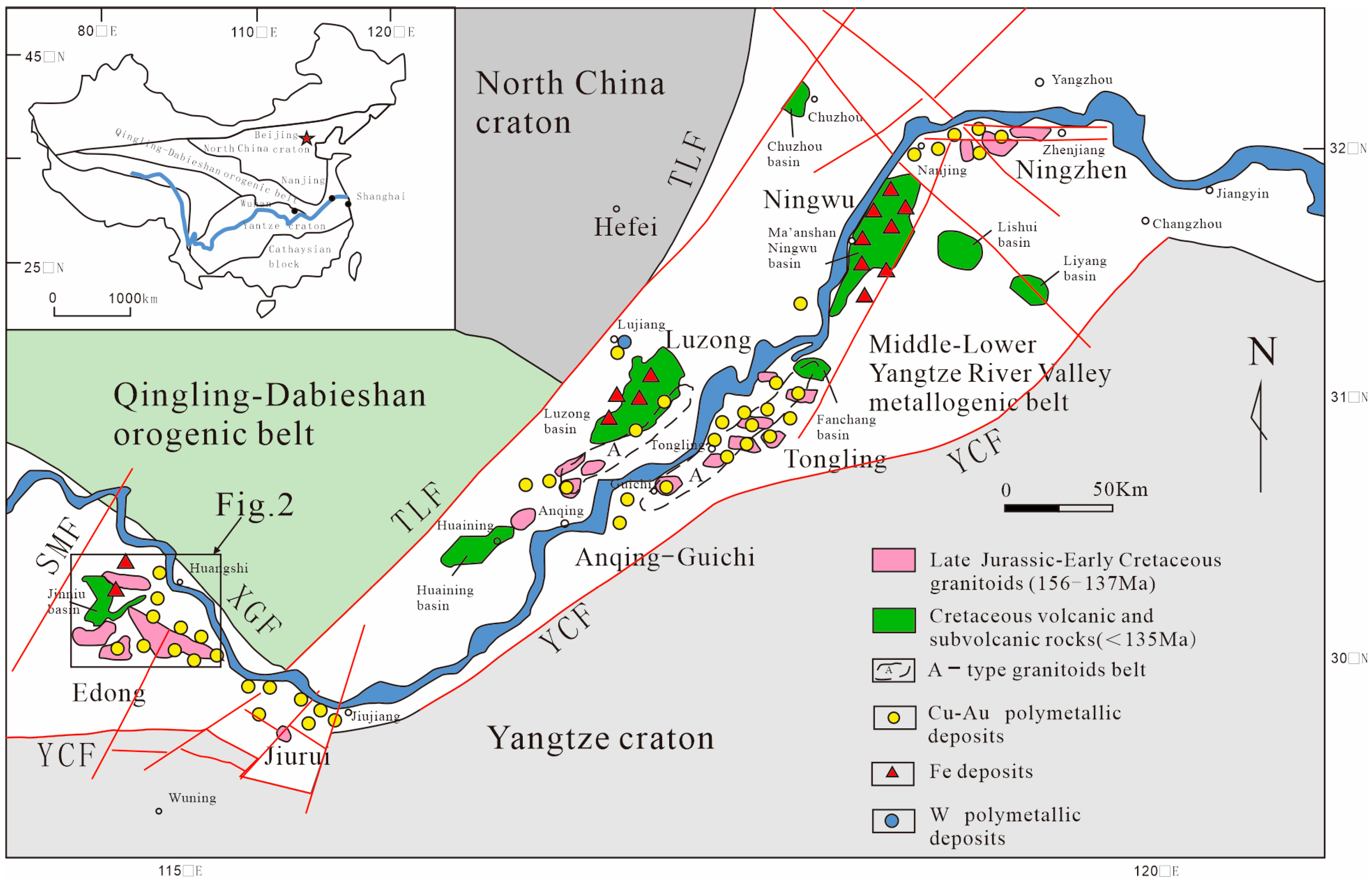
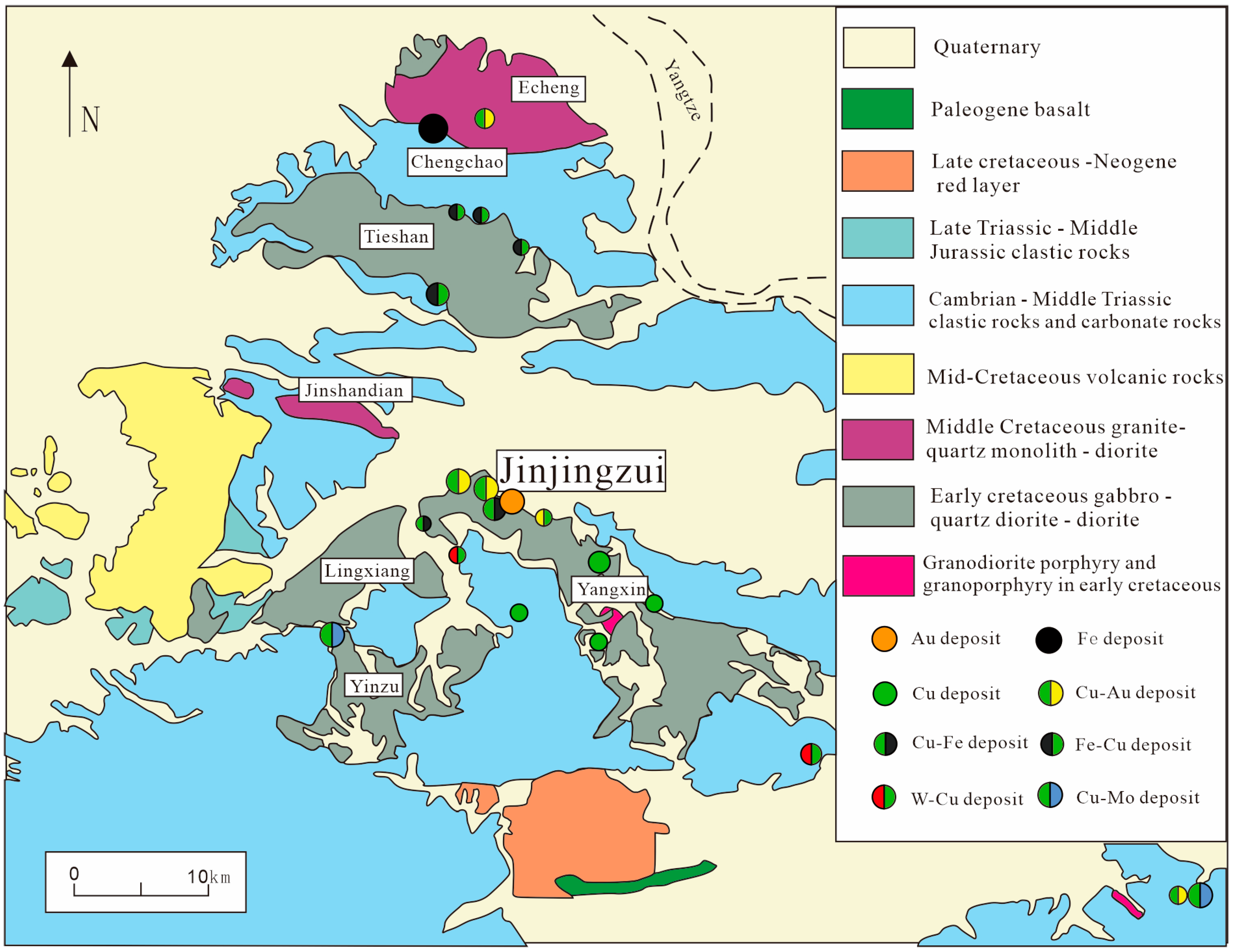
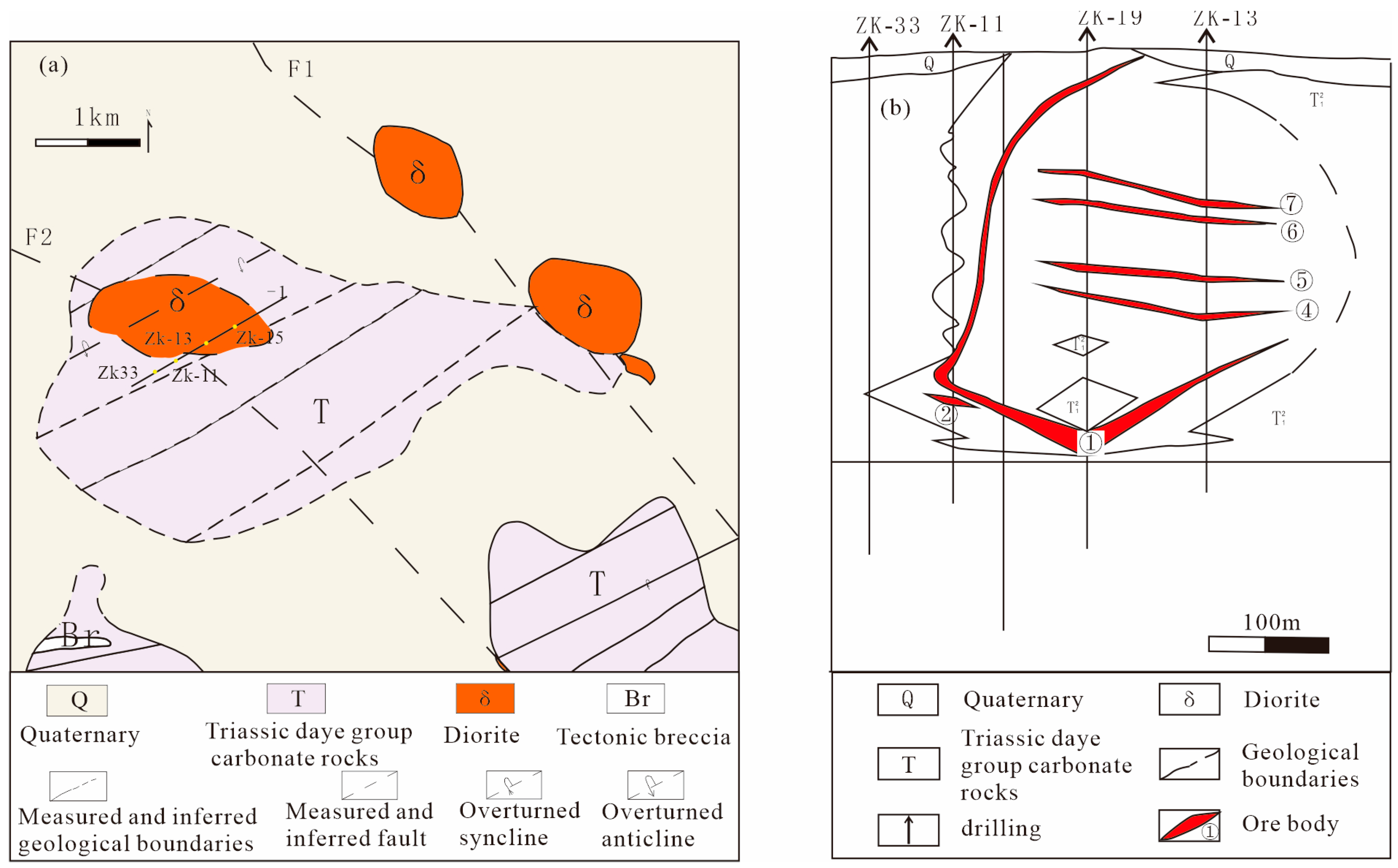
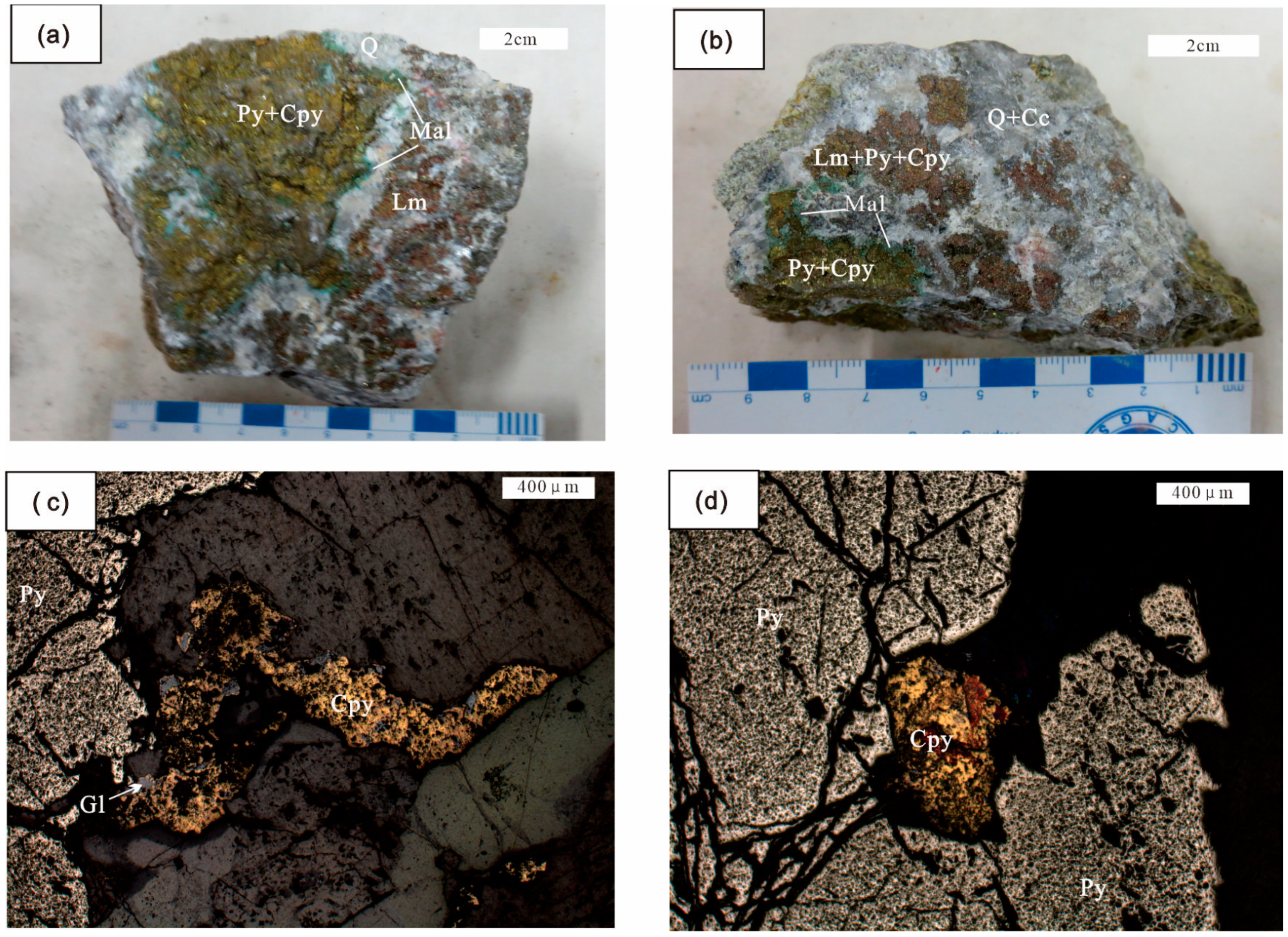
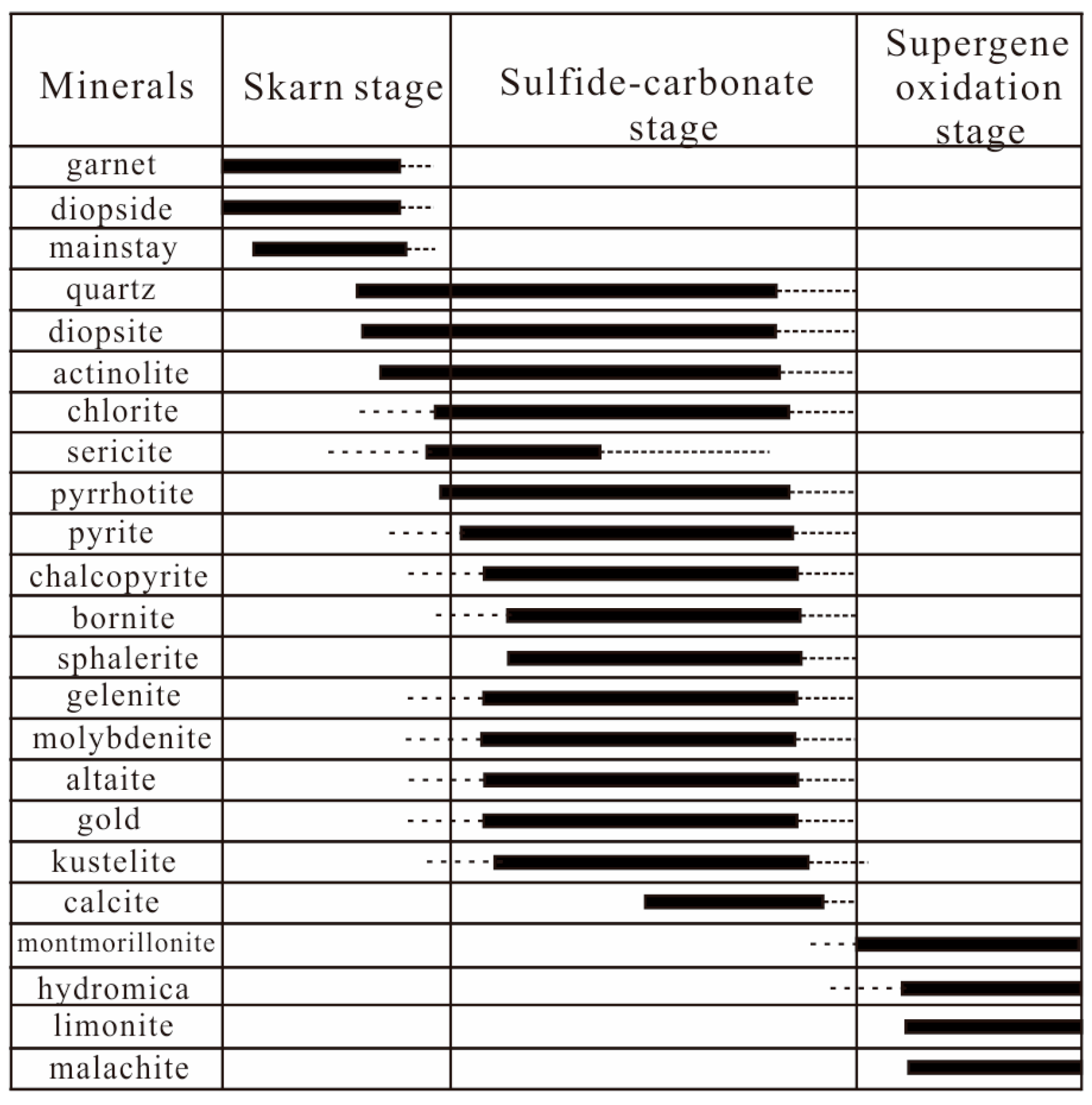

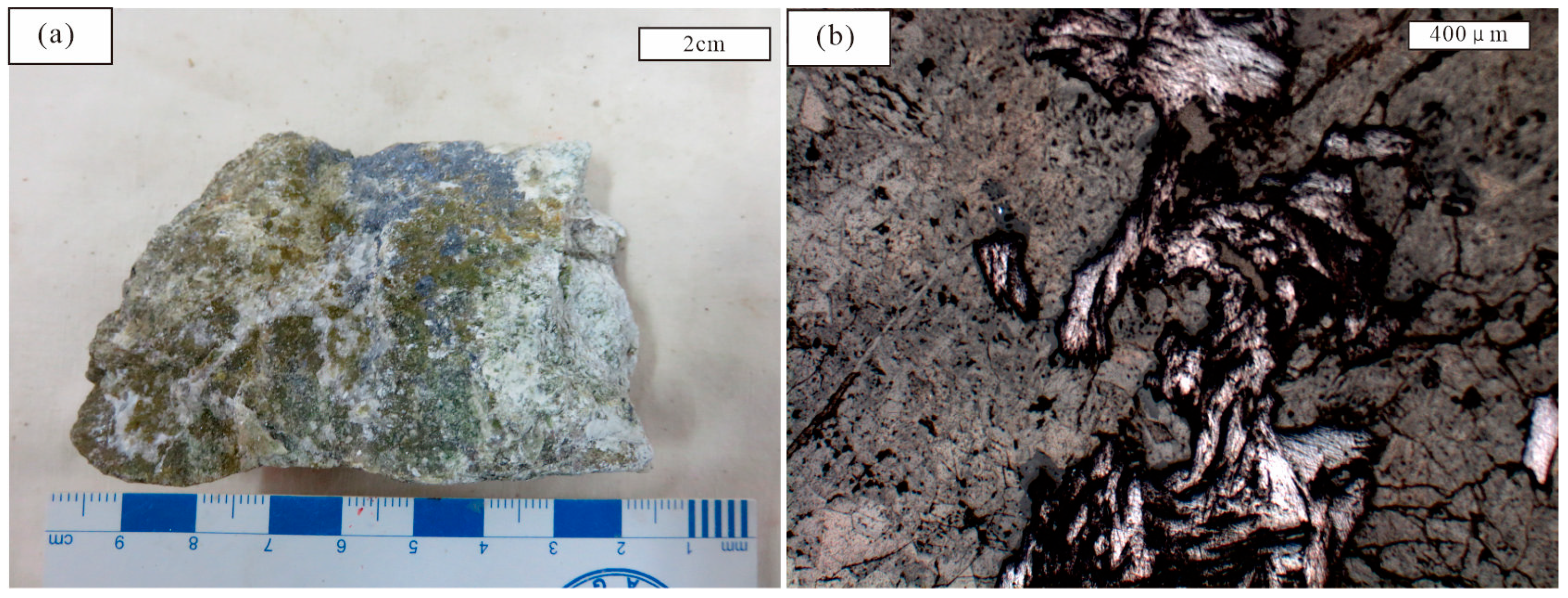

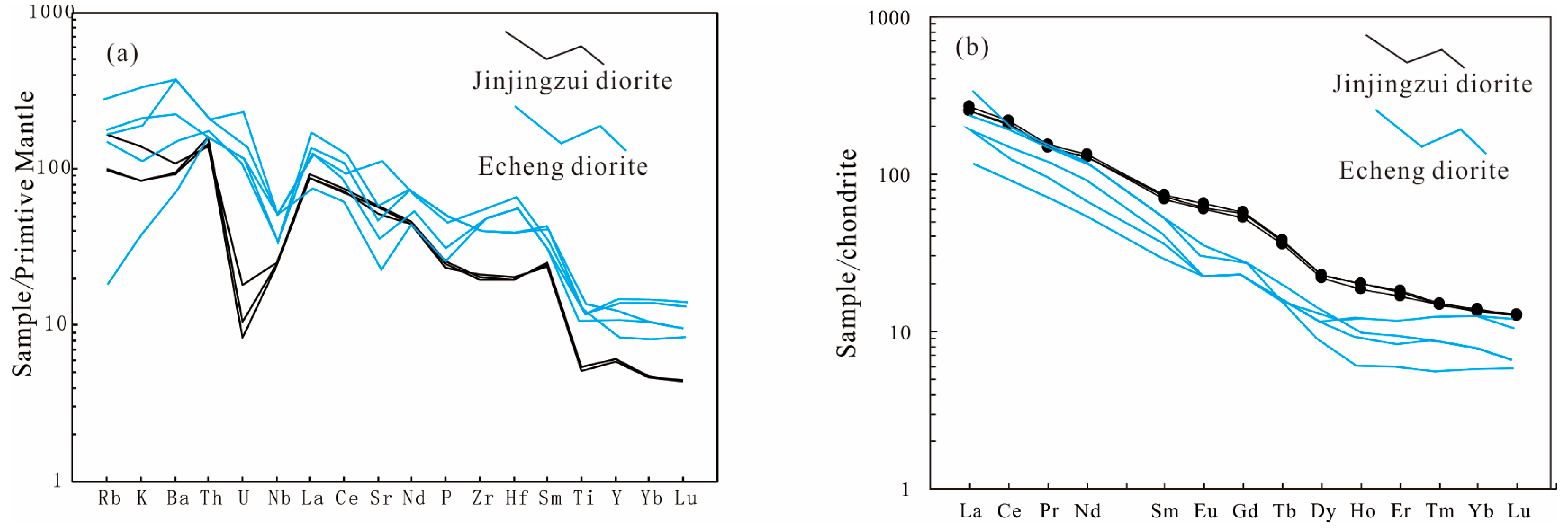
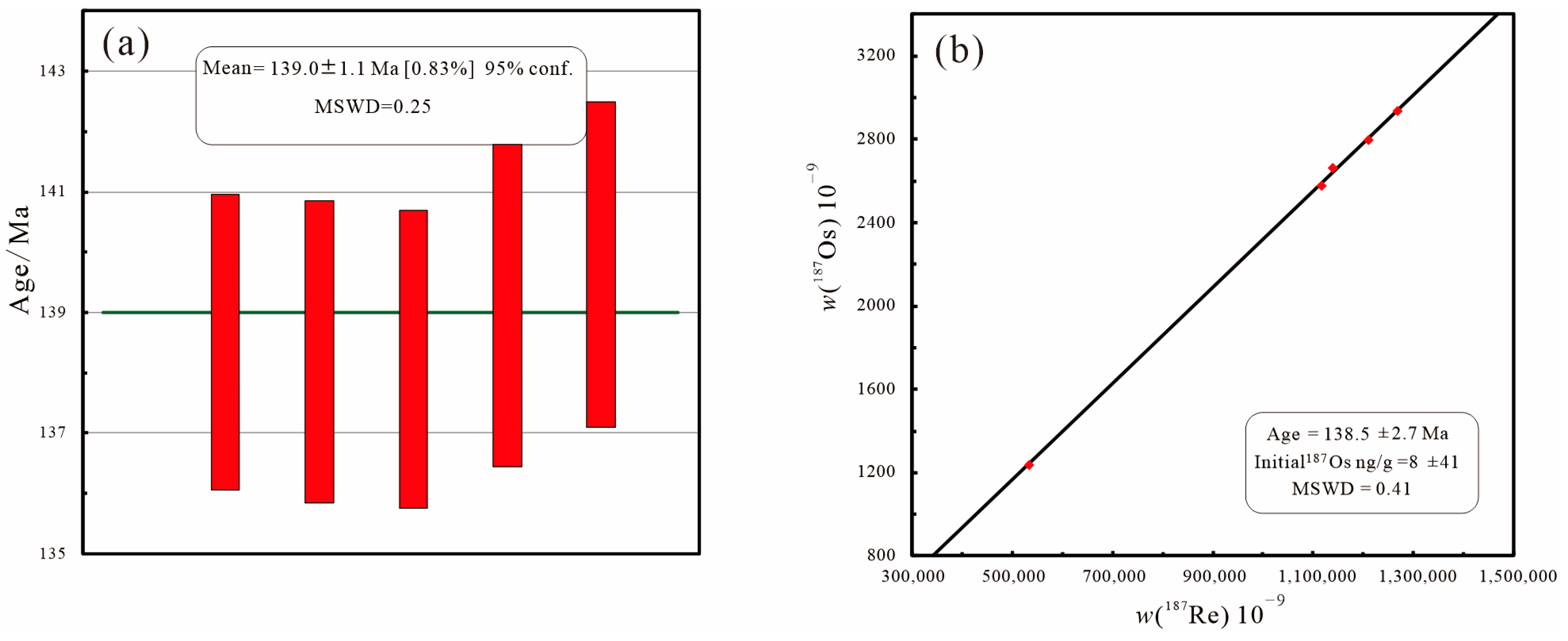
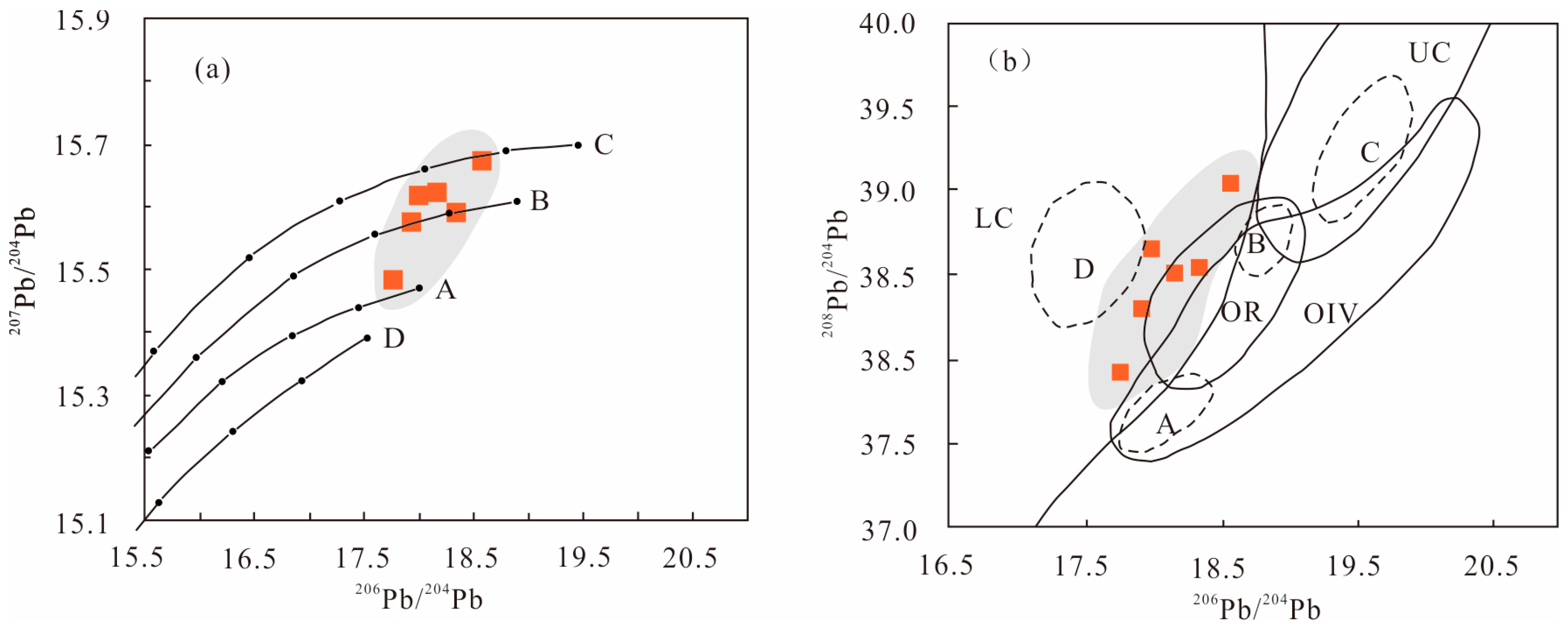
| Sample | SiO2 | TiO2 | Al2O3 | TFe2O3 | MnO | MgO | CaO | Na2O | K2O | P2O5 | LOI | Total | Mg # | A/CNK | NaO2 + K2O |
| JJZ-7 | 53.74 | 1.08 | 17.7 | 8.49 | 0.10 | 2.15 | 7.71 | 4.21 | 2.49 | 0.5 | 1.82 | 99.98 | 31.08 | 0.75 | 6.7 |
| JJZ-8 | 52.25 | 1.09 | 17.44 | 8.71 | 0.10 | 2.11 | 8.73 | 4.01 | 2.46 | 0.54 | 2.51 | 99.95 | 30.18 | 0.69 | 6.46 |
| JJZ-9 | 55.22 | 1.06 | 17.6 | 5.53 | 0.06 | 2 | 7.45 | 3.96 | 4.07 | 0.52 | 2.47 | 99.94 | 39.17 | 0.72 | 8.03 |
| Sample | Rb | Ba | Th | U | Nb | Sr | Zr | Hf | Yb | La | Ce | Pr | Nb | Nd | Sm |
| JJZ-7 | 63.12 | 643.36 | 12.38 | 0.17 | 17.22 | 1194.21 | 237.17 | 6.27 | 2.28 | 60.17 | 124.9 | 13.87 | 17.22 | 59.46 | 10.53 |
| JJZ-8 | 62.68 | 657.32 | 13.52 | 0.22 | 17.51 | 1223.91 | 225.37 | 6.04 | 2.29 | 63.21 | 132.12 | 14.67 | 17.51 | 61.71 | 11.21 |
| JJZ-9 | 105.69 | 752.81 | 11.95 | 0.38 | 17.91 | 1087.36 | 220.68 | 6.06 | 2.34 | 60.05 | 127.41 | 14.06 | 17.91 | 59.95 | 10.94 |
| Sample | Eu | Gd | Tb | Dy | Ho | Er | Tm | Yb | Lu | Y | ΣREE | δEu | (La/Yb)N | ||
| JJZ-7 | 3.48 | 10.86 | 1.35 | 5.55 | 1.05 | 2.77 | 0.38 | 2.28 | 0.33 | 26.88 | 296.97 | 1 | 18.94 | ||
| JJZ-8 | 3.73 | 11.79 | 1.41 | 5.71 | 1.13 | 2.93 | 0.38 | 2.29 | 0.32 | 27.64 | 312.61 | 0.99 | 19.8 | ||
| JJZ-9 | 3.56 | 11.48 | 1.4 | 5.76 | 1.15 | 3.02 | 0.39 | 2.34 | 0.32 | 27.93 | 301.81 | 0.97 | 18.42 |
| Samples | Weight (g) | w(Re) (×10−6) | w(Commons Os) (×10−9) | w(187Re) (×10−6) | w(187Os) (×10−9) | Age (Ma) | |||||
|---|---|---|---|---|---|---|---|---|---|---|---|
| Measured Value | Uncertainty | Measured Value | Uncertainty | Measured Value | Uncertainty | Measured Value | Uncertainty | Measured Value | Uncertainty | ||
| JJZ-1-1 | 0.00221 | 2018.58 | 26.76 | 0.1309 | 0.04 | 1268.72 | 16.82 | 2935.85 | 22.2 | 138.7 | 2.5 |
| JJZ-1-2 | 0.00245 | 1926.52 | 28.06 | 2.5859 | 0.04 | 1210.86 | 17.64 | 2798.81 | 16.4 | 138.6 | 2.6 |
| JJZ-4-1 | 0.00255 | 1775.82 | 24.35 | 1.0373 | 0.05 | 1116.14 | 15.31 | 2577.37 | 18.4 | 138.4 | 2.5 |
| JJZ-4-2 | 0.00234 | 847.91 | 13.29 | 0.3173 | 0.02 | 532.93 | 8.35 | 1238.80 | 8.5 | 139.4 | 2.7 |
| JJZ-4-3 | 0.00222 | 1813.77 | 29.09 | 0.6757 | 0.05 | 1139.99 | 18.29 | 2663.06 | 15.8 | 140.1 | 2.8 |
| Sample | Mineral | δ34S (‰) | 206Pb/204Pb | 207Pb/204Pb | 208Pb/204Pb | 208Pb/206Pb | 208Pb/207Pb | 206Pb/207Pb |
|---|---|---|---|---|---|---|---|---|
| JJZ-10 | pyrite | 5.9 | 18.020 | 15.610 | 38.650 | 2.145 | 2.477 | 1.155 |
| JJZ-11 | pyrite | 2.3 | 17.770 | 15.480 | 37.910 | 2.134 | 2.449 | 1.144 |
| JJZ-12 | pyrite | −2.4 | 17.930 | 15.570 | 38.300 | 2.136 | 2.460 | 1.151 |
| JJZ-13 | pyrite | 2.2 | 18.170 | 15.620 | 38.510 | 2.119 | 2.465 | 1.163 |
| JJZ-15 | pyrite | 2.2 | 18.580 | 15.670 | 39.050 | 2.101 | 2.492 | 1.186 |
| JJZ-16 | pyrite | 8.4 | 18.350 | 15.590 | 38.540 | 2.101 | 2.473 | 1.176 |
| Deposit | Sample | w(Re) (×10−6) | w(Commons Os) (×10−9) | w(187Re) (×10−6) | w(187Os) (×10−9) | Cite |
|---|---|---|---|---|---|---|
| Jinjingzui Au deposit | JJZ-1-1 | 2018.58 | 0.13 | 1268.72 | 2935.85 | This study |
| JJZ-1-2 | 1926.52 | 2.59 | 1210.86 | 2798.81 | ||
| JJZ-4-1 | 1775.82 | 1.04 | 1116.14 | 2577.37 | ||
| JJZ-4-2 | 847.91 | 0.32 | 532.93 | 1238.80 | ||
| JJZ-4-3 | 1813.77 | 0.68 | 1139.99 | 2663.06 | ||
| Tongshankou Cu-Mo deposit | TSK5 | 224.30 | 0.30 | 141.00 | 334.60 | [40] |
| TSK10 | 203.60 | 0.21 | 128.00 | 306.27 | ||
| TSK1 | 84.60 | 0.53 | 53.20 | 127.30 | [7] | |
| TSK2 | 135.40 | 0.37 | 85.10 | 203.90 | ||
| TSK3 | 75.40 | 0.33 | 47.40 | 113.60 | ||
| TSK4 | 110.60 | 0.39 | 69.50 | 167.80 | ||
| TSK5 | 99.50 | 0.32 | 62.60 | 150.40 | ||
| TSK6 | 177.00 | 0.53 | 111.20 | 266.30 | ||
| Tonglushan Cu-Fe-Au deposit | TLS3 | 665.40 | 0.53 | 418.20 | 961.39 | [40] |
| TLS4 | 305.70 | 0.27 | 192.10 | 442.69 | ||
| TLSB7 | 261.40 | 0.04 | 164.30 | 377.60 | [10] | |
| TLSB7 | 263.70 | 0.04 | 165.70 | 387.10 | ||
| TLSB16 | 432.50 | 0.20 | 271.80 | 617.90 | ||
| Qianjiawan Cu-Au deposit | QJW1 | 334.90 | 0.59 | 210.50 | 483.28 | [40] |
| Ruanjiaran W-Cu deposit | RJW4 | 24.80 | 0.05 | 15.59 | 37.34 | |
| Fengshandong Cu-Mo deposit | FSD4 | 436.50 | 0.64 | 274.40 | 659.20 | |
| Jilongshan Cu-Au deposit | WJ247 | 383.00 | 0.54 | 240.70 | 600.00 | [41] |
| WJ267 | 817.40 | 0.08 | 547.70 | 1360.00 | ||
| WJ323 | 174.30 | 0.08 | 109.50 | 274.20 | ||
| WJ328 | 2419.60 | 0.26 | 1520.80 | 3845.00 | ||
| WJ602 | 764.70 | 0.02 | 480.60 | 1184.00 | ||
| ZK39-1 | 298.81 | / | 187.81 | 467.34 | [17] | |
| ZK39-2 | 347.75 | / | 218.58 | 556.48 | ||
| 210CM28-1 | 470.16 | / | 295.51 | 747.53 | ||
| 210CM28-2 | 466.10 | / | 292.96 | 731.60 | ||
| Jiguanzui Au-Cu deposit | JGZB96 | 425.70 | 0.13 | 267.50 | 619.30 | [10] |
| JGZB97 | 500.40 | 0.42 | 314.50 | 718.90 | ||
| JGZB100 | 1152.00 | 0.89 | 724.00 | 1673.50 | ||
| ZK2412-7 | 810.80 | 0.14 | 509.60 | 1173.00 | ||
| ZK2412-9 | 785.90 | 0.14 | 494.00 | 1138.00 | ||
| Taohuazui Au-Cu deposit | JGZB146 | 1009.00 | 0.12 | 634.00 | 1464.00 | [11] |
| JGZB147 | 371.30 | 0.48 | 233.40 | 537.60 |
| Deposit | Mineral | Method | Age (Ma) | Cite |
|---|---|---|---|---|
| Jinjingzui Au deposit | molybdenite | Re–Os | 138.5 ± 2.7Ma | This study |
| Tongshankou Cu-Mo deposit | molybdenite | Re–Os | 143.8 ± 2.6 | [7] |
| phlogopite | 40Ar-39Ar | 143.8 ± 0.8 | ||
| phlogopite | 40Ar-39Ar | 143 ± 0.3 | [44] | |
| molybdenite | Re–Os | 142.9 ± 1.8 | [11] | |
| Tonglushan Cu-Fe-Au deposit | molybdenite | Re-Os | 138.1 ± 1.8 | |
| Re–Os | 137.8 ± 1.7 | |||
| Re–Os | 137.3 ± 2.4 | [10] | ||
| phlogopite | 40Ar-39Ar | 140.3 ± 1.1 | [11] | |
| Qianjiawan Cu-Au deposit | molybdenite | Re–Os | 137.7 ± 1.7 | [10,40] |
| Ruanjiaran W-Cu deposit | molybdenite | Re–Os | 143.6 ± 1.7 | [11] |
| Fengshandong Cu-Mo deposit | molybdenite | Re–Os | 144.0 ± 2.1 | |
| Jilongshan Cu-Au deposit | molybdenite | Re–Os | 150.8 ± 0.82 | [17] |
| molybdenite | Re–Os | 149.5 ± 1.2 | [41] | |
| Jiguanzui Au-Cu deposit | molybdenite | Re–Os | 138.2 ± 2.2 | [10] |
| Tieshan Fe deposit | phlogopite | 40Ar-39Ar | 140.9 ± 1.2 | [43] |
| Chengchao Fe deposit | phlogopite | 40Ar-39Ar | 132.6 ± 1.4 | |
| Jinshandian Fe deposit | phlogopite | 40Ar-39Ar | 131.6 ± 1.2 | |
| Taohuazui Au-Cu deposit | molybdenite | Re–Os | 139.4 ± 2.0 | [11] |
| phlogopite | 40Ar-39Ar | 139.9 ± 1.1 |
Disclaimer/Publisher’s Note: The statements, opinions and data contained in all publications are solely those of the individual author(s) and contributor(s) and not of MDPI and/or the editor(s). MDPI and/or the editor(s) disclaim responsibility for any injury to people or property resulting from any ideas, methods, instructions or products referred to in the content. |
© 2025 by the authors. Licensee MDPI, Basel, Switzerland. This article is an open access article distributed under the terms and conditions of the Creative Commons Attribution (CC BY) license (https://creativecommons.org/licenses/by/4.0/).
Share and Cite
Li, Y.; Cheng, C.; Yao, Y.; Yan, Q. Age and Source of the Jinjingzui Skarn-Type Gold Deposit in the Southeastern Hubei Province, China. Appl. Sci. 2025, 15, 2763. https://doi.org/10.3390/app15052763
Li Y, Cheng C, Yao Y, Yan Q. Age and Source of the Jinjingzui Skarn-Type Gold Deposit in the Southeastern Hubei Province, China. Applied Sciences. 2025; 15(5):2763. https://doi.org/10.3390/app15052763
Chicago/Turabian StyleLi, Yan, Chun Cheng, Yuan Yao, and Qinghua Yan. 2025. "Age and Source of the Jinjingzui Skarn-Type Gold Deposit in the Southeastern Hubei Province, China" Applied Sciences 15, no. 5: 2763. https://doi.org/10.3390/app15052763
APA StyleLi, Y., Cheng, C., Yao, Y., & Yan, Q. (2025). Age and Source of the Jinjingzui Skarn-Type Gold Deposit in the Southeastern Hubei Province, China. Applied Sciences, 15(5), 2763. https://doi.org/10.3390/app15052763





